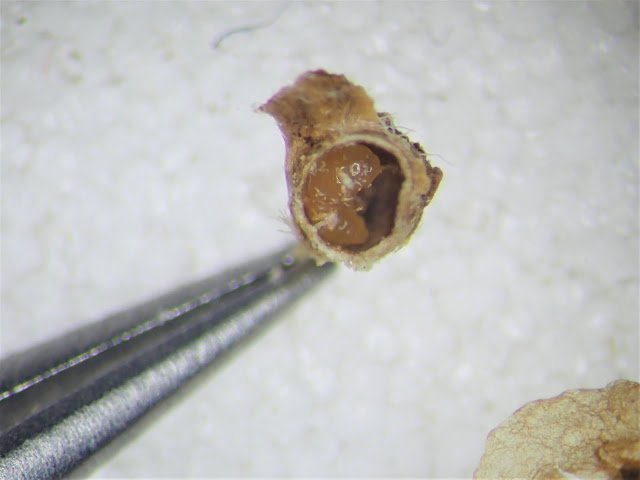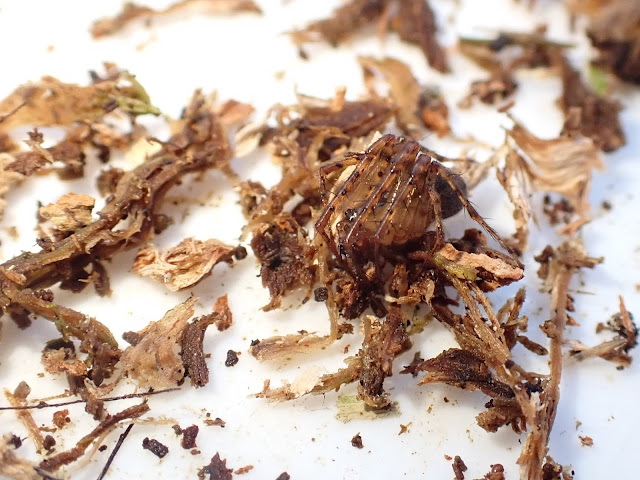Apologies for the slightly dramatic title of this post, I was going to call it 'Mid-January Update' but that seemed a bit kind of lame. Anyway, here's the mid-January update to my Spiders and Flies Challenge.
In a nutshell, my efforts to find spiders and flies this past fortnight have not been anywhere near as intense as they should have been. The weather has reverted to the grey, wet and windy conditions that are typical for this time of year and my enthusiasm for wandering cold, wet woodland has yet to take off (as can be seen with a quick glance at the dates below...)
 |
| The spiders |
 |
| And the flies |
I hope you can read those, clicking on them will enlarge the image. Essentially they show that I haven't added much of late and that already I'm falling behind with my iRecord submissions. I'm finding the Uig Wood spiders mildly frustrating, because they seem to consist of a very limited number of species. Tenuiphantes zimmermanni is the commonest denizen of tussocks and mosses on the woodland floor and I'm finding lots of female specimens, though strangely only a couple of males so far. But I have yet to find Tenuiphantes tenuis which should definitely be here. This is about the best image I could manage of the left pedipalp of a male Tenuiphantes zimmermanni. The entire spider is around 3mm in length, hence you'll appreciate that the pedipalp itself is somewhat miniscule.
Below is what a proper picture of the pedipalp looks like. Note the red arrow pointing at a small 'tooth', this 'tooth' being an important feature which helps differentiate zimmermanni from tenuis. You can see it on the photo above too, though in my image you're viewing the palp obliquely from below, so it doesn't quite match the image below. Damned fiddly things to orientate correctly, particularly when the spider is suspended in alcohol and keeps falling onto its back!
 |
| See original at Tenuiphantes zimmermanni – Wiki der Arachnologischen Gesellschaft e. V. (arages.de) |
The other spiders I'm finding with regularity are from the genus Metellina. These also happen to be the largest spiders I'm finding in Uig Wood, what I'd call a proper macro-spider as opposed to the linyphilids which are mostly micro-spiders, though some of them do approach macro size (I've coined those phrases myself, you quite rightly won't find them written in the texts).
This 'covering your face' pose appears to be typical for Metellina spiders after they've crash landed into the tray. I guess it's a good cryptic pose to adopt, certainly I've overlooked them several times when they are in this tucked-in position. It's only when they burst into their lumbering escape mode that they become really obvious.
 |
| Female Metellina merianae in lumbering escape mode |
Sadly for her, she didn't lumber quite fast enough and I popped her into alcohol for subsequent examination. There are several species of Metellina on Skye and I intend to keep track of which ones I see and where. Though currently, thanks to the latest lockdown, the 'where' is always going to be somewhere around Uig. As a brief aside, many birders have latched on to an idea that, though not new, is currently proving popular - birding within a five mile radius of home. It offers more flexibility than the #BWKM0 that proved so popular in the first national lockdown, yet fulfils the 'stay local' criteria that we're being told to adhere to.
I had a quick think about this. Currently, at least, the covid threat is pretty low on Skye. For myself, I think the opportunities offered by this 5MR idea far outweigh the risks. I plotted a map, just to see what was on offer.
 |
| My new Patch area - a circle ten miles wide with 2/3 of it being (rather helpfully) on land |
I shall blog about this in depth elsewhere, but I like that it provides me the opportunity to add extra dots to the species maps. I must keep the batteries in my GPS fresh and remember to pack my OS map with me whenever I head out.
Back to the spiders. I eventually added a second Metellina species to the tally. This was a male and immediately stood out as being different due to the pale orange wash across the upperside of the abdomen. I could see that it was an adult so popped it straight into the alcohol pot and checked it out once back indoors.
 |
| Note the obviously forked paracymbium (arrowed) |
The forked tip and overall shortness of the paracymbium allows us to identify this as an adult male Metellina mengei. For comparison, below is the pedipalp of Metellina merianae, which is the one I usually find here.
 |
| Not in focus, but you can see it is very long and upright, and strongly bent after the middle |
The other recent addition to the spider tally is one that I immediately recognised, having already encountered it last year. The long spinnerets and overall rather chunky look are very distinctive. This is Cryphoeca silvicola, a subadult male (note the pedipalps aren't fully developed) but still readily recognisable, despite it being a mere 2mm in length. It's a common spider, so I'm sure I shall bump into one again soon.
 |
| Cryphoeca silvicola - subadult male |
Right - enough of the spiders, let's move on to the flies. Despite having only recorded seven species so far this year, I managed three lifers in the first half of January. Two of these were sphaerocerids (Lesser Dungflies) that I sieved from grass tussocks and the third was a gall midge, found after a targeted search the day after learning of its existence. This is a truly abysmal pic of a Downy Birch catkin that has had most of the seeds removed, revealing the swollen and galled seeds glued to the central spindle. The species involved is Semudobia skuhravae and is one of three in the genus to form galls in birch catkins. I haven't found the other two yet, but I will. Finding catkins here isn't as easy as you'd expect, I searched maybe twenty trees and found only two! I shall have to find some birches in a more sheltered spot, hopefully they will have retained their catkins for longer.
Here's a very nice picture of the same thing, taken by a professional on the Bladmineerders site
Being the curious type, I opened up one of the galls just to double-check the inhabitant was indeed dipterous. A tiny orange grub blinked up at me, then retreated to the bottom of its gall. Yep, that's the badger alright!
 |
| Semudobia skuhravae grub in its gall |
There are ten or so galls on what's left of the two catkins I collected, plus the opened gall with the grub inside, all currently sat on my windowsill. I'm hoping they will successfully emerge in the spring so I can see what they look like as adults too. I did notice a couple of black pupae in the catkin, I think these must be parasitic wasps that have already killed their host. With luck, this means the rest are unparasitised. We shall see.
Tomorrow I have a WeBS count to undertake, which means I'll be using my car for the first time in a while. I think I shall head further into my 5MR zone, see what I can find elsewhere. I've stashed my sieve and tray under a fallen tree in Uig Wood - they are too big to fit into my rucksack and I simply couldn't be bothered with lugging them up and down the hill with me every time I headed out. Fingers crossed nobody nabs them! I've attached a note in waterproof ink, but realistically the chances of anyone finding them are pretty low and the risk of them being stolen if found are even lower.
I'll do another of these round-up type blogs at the end of January. My mid-month tallies are 10 spiders (plus 2 harvestmen) and 7 flies. I'd like to see both of those tallies doubled by month end, maybe trebled in the case of the flies. But expect more posts between now and then!
As for my challenger, he recorded his first hopper today. And so it begins.......










your spreadsheet dates look rather similar to my beetle ones! Low numbers so far and only 2 lifers. Looking at my 5MR patch and it's pretty dire. All the decent sites fall 'just' outside. Bugger...
ReplyDeleteYou mean all of the 'known' decent sites are just outside your 5MR...
DeleteMy local patch is about to become a housing development - eek! At least the vismig spot will be still open and I can't really defend the wildlife value of a disused quarry where two teens have drowned in recent years.
ReplyDeleteThere are some nice inverts found on submerged corpses, not sure any have a high enough status to stop a housing development though.
Delete